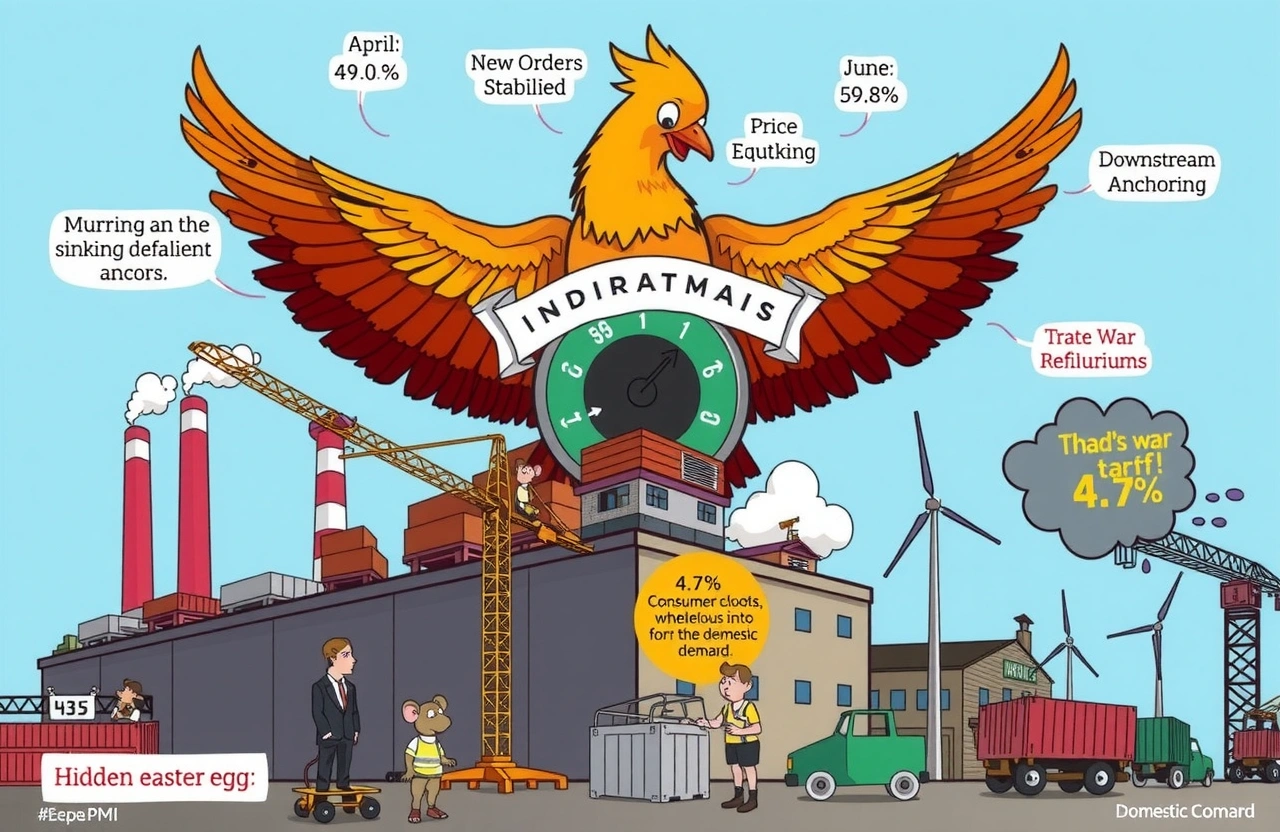New data reveals China’s manufacturing sector showing clear recovery signs amid global trade turbulence. Released jointly by the National Bureau of Statistics Service Industry Survey Center and China Federation of Logistics & Purchasing (CFLP), the latest Purchasing Managers’ Index report showed manufacturing PMI climbing to 49.7% in June – the second consecutive monthly improvement since April’s contraction. Crucially, the new orders sub-index crossed the pivotal 50% expansion threshold for the first time in three months, suggesting renewed market confidence.
Manufacturing PMI Expansion Momentum Accelerates
Analysis of the June 2025 PMI figures reveals consistent quarterly gains despite external pressures. The manufacturing sector PMI trajectory tells a compelling story:
- April 2025: 49.0%
- May 2025: 49.5%
- June 2025: 49.7%
Though remaining below the neutral 50% mark, the consecutive positive increments signal strengthening industrial fundamentals. Zhang Liqun (张立群), CFLP Special Analyst, attributes this manufacturing PMI expansion to “the cumulative effects of policy stimulus gradually permeating the real economy.”
External Trade Headwinds Diminishing
The second-quarter manufacturing PMI improvement follows turbulent U.S. tariff adjustments that initially disrupted supply chains. Wen Tao (文韬), analyst at China Logistics Information Center, observes: “With phased easing of Sino-American trade relations, external interference factors are weakening.” This normalization of trade conditions allowed domestic manufacturers to refocus on productivity optimization.
Core Indicators Signal Robust Demand Recovery
The June manufacturing PMI breakthrough stems from simultaneous improvements across dual engines: production output and market demand.
Production Expansion Accelerates
The production index climbed to 51.0% in June, rising 0.3 percentage points from May. This sustained manufacturer confidence translates directly into:
- Increased raw materials procurement
- Higher equipment utilization rates
- Expanded workforce deployment
New Orders Return to Growth Territory
The most encouraging development came in the new orders component – surging 0.4 percentage points to 50.2% after trailing below the expansion threshold since April. This rebound indicates:
- Domestic consumption fatigue easing
- International buyers recalibrating sourcing strategies
- Downstream inventory restocking cycles initiating
The simultaneous manufacturing PMI expansion signals a healthier economic synchronization absent during previous recoveries.
Price Stabilization and Broad-Based Industry Recovery
Complementing the manufacturing PMI expansion came significant price normalization after prolonged deflationary pressures.
Input-Output Price Equilibrium
June witnessed synchronized price stabilization:
- Raw material purchasing prices halted three-month decline pattern
- Finished goods selling prices ceased downward trajectory
Wen Tao explains this alignment: “The price trends demonstrate improved coordination between upstream suppliers and downstream manufacturers.” Such balance reduces margin pressure across industrial chains.
Industry Recovery Widens Significantly
The breadth of manufacturing PMI gains proved exceptionally encouraging:
- 11 of 21 monitored industrial sectors registered expansion (up from 7 in May)
- Transport equipment and electronics manufacturing led gains
- Even traditionally soft sectors like textiles showed stabilization
As Wen Tao emphasizes: “The recovery’s most striking aspect is its universality across industrial segments.”
Construction Sector Fuels Economic Momentum
Beyond manufacturing PMI expansion, infrastructure investment demonstrated robust vitality. The construction business activity index surged to 52.8% in June – a notable 1.8 percentage point monthly gain.
Infrastructure Projects Driving Activity
State Council-backed initiatives catalyzed site progress:
- Real estate construction maintained positive growth
- Civil engineering projects expanded footprint
- Special bond utilization widened beyond land acquisition
He Hui (何辉), CFLP Vice President, highlights policy tailwinds: “Special bond applications now extend to existing commercial property purchases and government investment funds.” This broadening effectively multiplies infrastructure stimulus.
Financial Sector Bolsters Support Mechanisms
Complementing physical construction progressed:
- Financial industry activity index surpassed 60%
- New banking orders accelerated substantially
- Corporate credit availability improved
Zhao Qinghe (赵庆河), National Bureau of Statistics Senior Statistician, confirms: “Financial institutions significantly strengthened support for real economy demands.”
Non-Manufacturing Resilience Despite Sectoral Variations
The non-manufacturing sector remained expansionary at 50.5%, though internal divergences emerged:
Consumer-Sensitive Segments Temporarily Cool
Areas linked to discretionary spending softened:
- Retail sales activity dipped
- Road transport volume eased
- Hospitality industries experienced notable slowdowns
Analysts consider this seasonal recalibration before peak summer demand. Zhao Qinghe notes compensations in services outlook: “Business expectation indices remain exceptionally high at 56.0%.”
Anticipated Summer Consumption Surge
Wu Wei (武威), China Logistics Information Center analyst, predicts imminent rebound: “Service industries will resurge with summer holiday spending.” Policy catalysts strengthen this outlook:
- Financial institutions prioritizing wholesale/retail loans
- Targeted hospitality sector lending programs
- Consumer finance innovations
Strengthening Domestic Drivers Underpin Future Trajectory
The manufacturing PMI expansion scenario sets favorable conditions for sustainable growth throughout 2025.
Policy Catalysts Amplifying
Beyond immediate manufacturing PMI outcomes, institutional frameworks establish runway:
- Monetary policy maintaining accommodative stance
- Fiscal measures reaching implementation phase
- Sector-specific consumption stimulus plans
Endogenous Recovery Dynamics Unfolding
Notably, manufacturing PMI improvements occurred without:
- Major property market interventions
- Debt-driven infrastructure blitz
- Export subsidy escalations
He Hui observes this organic quality: “Economic drivers are transitioning toward self-sustaining momentum.”
Strategic Implications for Manufacturing Enterprises
The current manufacturing PMI expansion creates actionable opportunities:
Operational Optimization Priorities
Production growth requires:
- Supply chain diversification protocols
- Automation integration roadmaps
- Workforce skill elevation programs
Demand Forecasting Adjustments
With new orders accelerating:
- Implement dynamic pricing models
- Develop tiered customer fulfillment systems
- Enhance inventory-to-sales analytics
Wu emphasizes consumer-facing linkages: “Manufacturers must strengthen ecosystem coordination with service industries.”
Positioning Businesses for Continued Expansion
The improving manufacturing PMI trajectory affirms China’s economic resilience, evidenced by the new orders index returning to expansion territory after prolonged weakness. Manufacturers should capitalize on this momentum by:
- Conducting quarterly vulnerability assessments against trade policy shifts
- Implementing digital supply chain visibility platforms
- Establishing workforce development partnerships
Monitor CFLP monthly PMI releases centrally while exploring sector-specific reports for precision strategy refinement. Finally, industry leaders should actively engage with provincial commerce bureaus regarding localized incentive programs. China’s manufacturing PMI expansion demonstrates that fundamentals endure beyond transient volatility.




